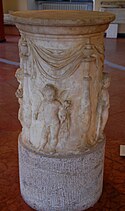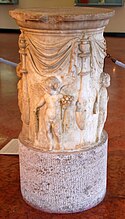Würzburg four seasons altar
The Würzburg four-seasons altar is a Roman ornate altar that dates from around AD 40.
The Würzburg Four Seasons Altar was found in 1886 at the Pincio on the site of the former Horti Sallustiani (Sallustic Gardens), a site that belonged to the Roman emperors. The altar was published immediately, but was quickly lost for a long time. It later emerged that the altar had been in a US private collection for decades. In 1966 he reappeared in Rome , in the antique trade of the art dealer Giorgio Fallani . There it was acquired by Erika Simon , who recognized the lost altar, for the antique collection of the Martin von Wagner Museum in Würzburg . After eighty years, the Italian state could no longer lay claim to the work. The work almost got into the Antikensammlung Berlin after Simon Friedrich Matz drew the younger man's attention to the altar and the latter pointed the work to the director of the West Berlin collection, Adolf Greifenhagen . But despite larger Berlin funds, Fallani sold the altar to Würzburg.
The round altar shows four putti at regular intervals , which are supposed to symbolize the four seasons based on their attributes. Winter is dressed as a farm laborer and also indicates activities in winter with a slaughtered animal and a wine amphora . The three other personifications allude to deities, which, as in the written tradition, for example in Ovid and Lucretius, symbolize the seasons. A flower garland is reminiscent of the spring deities Venus and Flora , ears of wheat and poppies refer to the goddess of fertility and summer Ceres . The putti of autumn is reminiscent of a satyr and is also equipped with a basket of grapes. It symbolizes the wine and autumn god Bacchus . The winter and spring putti, like the autumn and summer putti, face each other. The altar was probably not intended for ritual purposes, but rather an atmospheric decoration of a park. In the early imperial period, imperial princes such as putti were also depicted, so a propagandistic statement that went beyond the jewelry value is possible, which aimed at a positive development of the Julio-Claudian house .
The season altar made of fine crystalline white marble has a height of 73 centimeters and a diameter of 56.4 centimeters. Except for minor nicks, it is completely preserved. The putto representing the winter was not worked on after it was damaged during the chiselling work on the dead animal. The altar is dated to early Claudian times around the year 40 AD. It has the inventory number H 5056 .
literature
- Erika Simon : Giorgio Fallani and the Martin von Wagner Museum , In: Antike Welt 26 (1995), pp. 404-405
- Friederike Sinn : Seasons putti from the imperial villa , In: Ulrich Sinn , Irma Wehgartner (editor): Encounter with antiquity. Evidence from four millennia of Mediterranean culture in the south wing of the Würzburg Residence , Ergon, Würzburg 2001 ISBN 3-935556-72-1 , pp. 160–161
Web links
- Round altar with four seasons in the Arachne archaeological database


